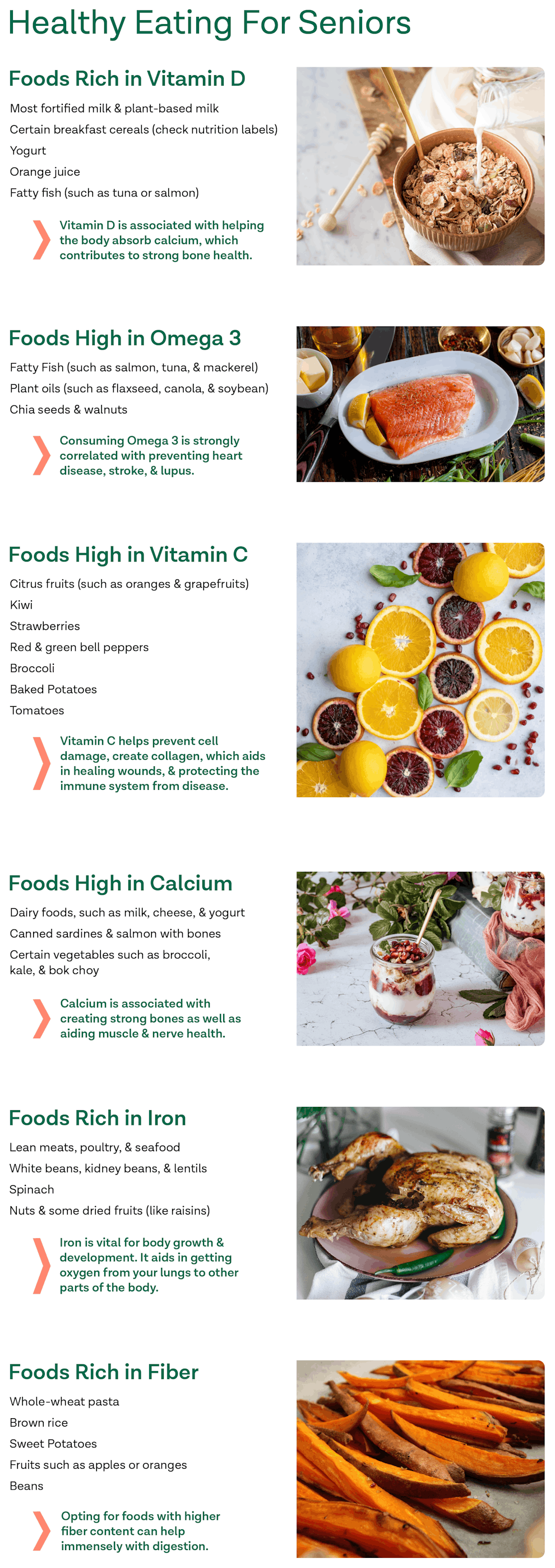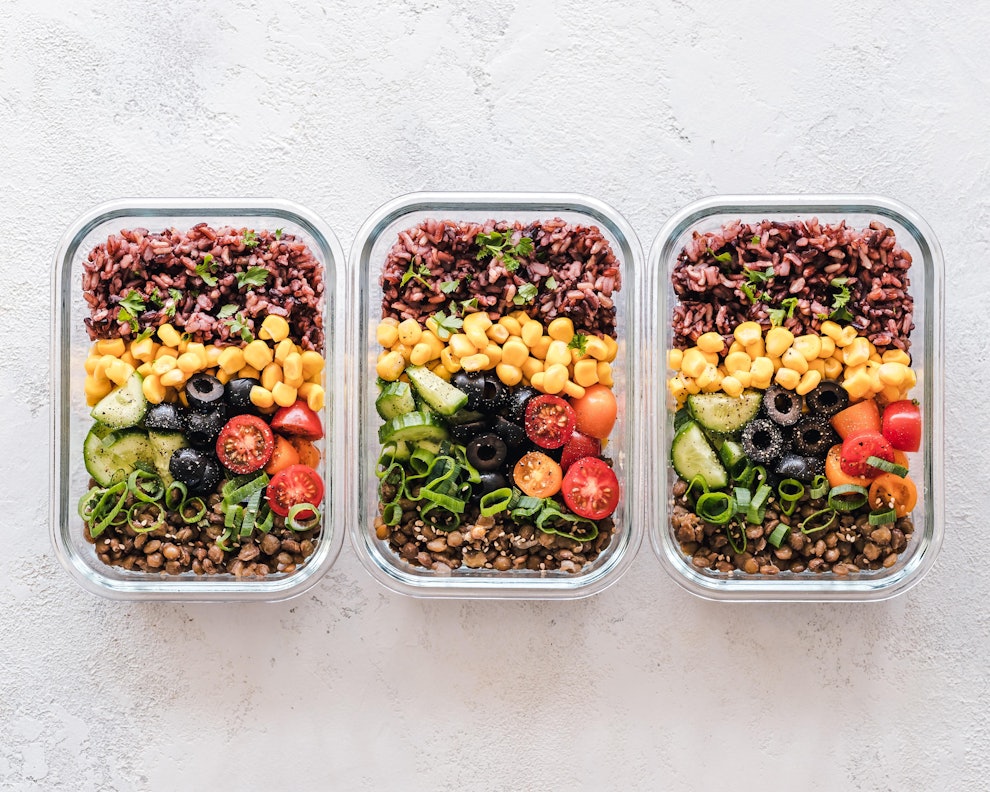Helpful Tips on Healthy Eating for Seniors
Article at a glance
As seniors age, their habits and diets often need to change in order to match the ways in which their bodies are changing.
Life changes, medical conditions, and metabolism slowing down can all contribute to dietary changes or daily routine alterations..
Choosing healthier food options can greatly increase a person’s energy, as well as their overall health because of the nutrients packed into healthier food groups. Maintaining a balanced diet, exercise routine, and water intake is key in receiving proper nutrition while aging.

Why Do Diets Need To Change as a Person Gets Older?
While each person is different, our bodies tend to change as we age. In the same way that a person will alter their diet when they go from a child to a teenager, or from a young adult into a middle-aged one, it only makes sense to follow suit as we age into our elderly years. Older adults need to adjust diets to fit certain health needs as they age to ensure a healthy body weight. So what does healthy eating for older adults look like?
Healthy Diets for Older Adults
In general, the USDA has dietary guidelines to help create a well-balanced diet. They recommend meals that cover all of the healthy food groups like lean proteins, leafy greens, low-fat dairy, etc. The website MyPlate can help give a better idea of what that looks like for different individuals of various ages and sexes. The important factors to take in when it comes to healthy eating are that specific dietary needs, health conditions, and age can affect what healthy eating looks like.

What Life Changes May Affect Eating Habits?
As a person ages, certain life changes and a person’s body may have an effect on eating habits. Some examples of these include:
Metabolism Slowing Down
Older adults may feel less motivated to be physically active, along with experiencing a decrease in muscle mass. As a result, the body’s metabolism may begin to slow down, which can lead to the need to consume fewer calories altogether by lessening portion sizes or switching from routine big meals to smaller meals throughout the day.
Medical Conditions and Medications
It’s common for older adults to potentially face specific health issues that require diet changes, either to control the condition or to not interfere with specific medications. For example, if a person has high blood pressure, a healthcare provider may recommend consuming less sodium. Chronic diseases, such as heart disease, may also require additional changes such as less sugar or less red meat to ensure a healthy weight/lifestyle.
Loss of Appetite
Older adults often experience a decrease in appetite as they age, which can lead to eating less overall. While eating slightly less isn’t uncommon in seniors, it can also result in not receiving enough of the proper nutrients.
Inability to Care for Themselves as Easily
In some cases, older adults may experience difficulty caring for themselves the way they once did. This can lead to a higher dependence on prepared/frozen meals that may not have as many nutrients or health benefits compared to others.


How to Maintain a Healthy Diet
While eating healthy may look slightly different for everyone, there are a few recommendations that anyone should keep in mind, such as:
Focusing on Nutrient-Rich Foods
Eating healthy foods such as fruits and vegetables, low or full-fat milk, whole grains, seafood, and lean meats, all contain high levels of nutrients that are essential to overall health and well-being. Some examples of nutrients older adults should pay attention to include Omega 3, Vitamin C, Vitamin D, Calcium, and Iron.
Some examples of what older adults should avoid in their food are saturated fats, trans fats, and foods that are high in sodium and sugar. Saturated fat comes from animals while trans fat comes from processed foods like margarine, however, both of these fats can lead to cholesterol issues. Not to mention, consistently eating foods high in sugar can cause chronic health conditions such as diabetes and consistently eating foods high in sodium could cause high blood pressure.
Foods Rich in Vitamin D
Vitamin D is a nutrient associated with helping the body absorb calcium, which contributes to strong bone health. It’s also effective in helping the immune system fight off disease, and helps with muscle and nerve health.
- Most fortified milk and plant-based milk
- Certain breakfast cereals (check nutrition labels)
- Yogurt
- Orange juice
- Fatty fish (such as tuna or salmon)
- In smaller amounts, foods like mushrooms, cheese, and egg yolks also contain Vitamin D
Foods High in Omega 3
Omega 3 fatty acids affect the cell receptors and cell membranes in the body. They are strongly correlated with preventing heart disease, stroke, and lupus. It’s also been connected to possible cancer prevention.
- Fatty Fish (such as salmon, tuna, and mackerel)
- Plant oils (such as flaxseed, canola, and soybean)
- Chia seeds and walnuts
- Certain brands of eggs, milk, yogurt, and juices are fortified with Omega 3 (check the nutrition labels)
Foods High in Vitamin C
Vitamin C is an antioxidant that helps prevent cell damage. It’s essential in helping the body create collagen, which helps in healing wounds, and also helps protect the immune system from disease.
- Citrus fruits (such as oranges and grapefruits)
- Kiwi
- Strawberries
- Red and green bell peppers
- Broccoli
- Baked Potatoes
- Tomatoes
- Foods fortified with Vitamin C (check nutrition labels)
Foods High in Calcium
Calcium is the nutrient most commonly associated with creating strong bones, but it’s important for other reasons as well. Calcium is essential in aiding muscle and nerve health and even helps blood vessels move more blood through your body.
- Dairy foods, such as milk, cheese, and yogurt
- Canned sardines and salmon with bones
- Certain vegetables such as broccoli, kale, and bok choy
- Certain beverages and juices have added calcium, as well as certain brands of tofu and milk substitutes (check product nutrition labels)
Foods Rich in Iron
Iron is a nutrient and is vital for body growth and development. It creates hemoglobin and myoglobin, both proteins that aid in getting oxygen from your lungs to other parts of the body.
- Lean meats, poultry, and seafood
- White beans, kidney beans, and lentils
- Spinach
- Nuts and some dried fruits (like raisins)
Foods Rich in Fiber
Opting for foods with higher fiber content can help immensely with digestion.
- Whole-wheat pasta
- Brown rice
- Sweet Potatoes
- Fruits such as apples or oranges
- Beans

Choosing Healthier Convenience Food Options
It may not always be possible to buy fresh foods, but there are some ways to still select convenient, budget-friendly foods while striving to eat healthy. Frozen fruits and vegetables often contain the same nutrient levels as fresh produce. When choosing frozen/prepared meals, check the nutrition facts label for low sodium, no added sugars, low levels of saturated and trans fats, lean protein selections, and a balance of food types, e.g., vegetables, grains, meats. Avoid fried options as much as possible.
Drinking Plenty of Water
Staying hydrated is immensely important to overall health. Ideally, strive to drink eight 8‑ounce glasses of water per day. Additionally, drinking teas, 100% fruit juice, and even soup can help with hydration while providing other health benefits as well such as a boost to the immune system.
Meal Planning
Meal planning is exactly as it sounds— preparing meals (or even recipe ideas) in advance. Meal planning or prepping can help remove some of the stress involved in obtaining the correct amount of nutrients, calories, and variety for each meal. Here are a few tips to keep in mind:
Create a Plan in Advance
Deciding in advance what to eat can help alleviate the stress and frustration of what/how much food to eat. Choose the meals for each time of the day for the entire week. After deciding, make a list of everything needed to create the meals—and if you notice a particular food group lacking, adjust the meals if necessary.
Choose Budget-Friendly Options
Certain convenience options, like frozen fruits and vegetables, can easily be implemented into a meal planning schedule and may cost less in the long run.
Take Into Account Preparation Time
Some meals may take less time to make than others. In plenty of cases, cooking a large amount of food in advance and then freezing the leftovers in portions can help cut down on prep time without compromising any nutrients.
Keep Calories/Portion Sizes in Mind
Creating meals ahead of time can make it easier to portion out the appropriate servings. Doing some research about how many calories you should consume per meal, and talking with your healthcare provider about what a balanced plate looks like for you, can help make some decisions easier to navigate.

Reading Nutrition Labels
Trying to determine how many vitamins and nutrients are available in products can feel overwhelming but it doesn’t have to be. Checking the nutrition labels can help determine the percentage of nutrients available per serving, as well as whether the item is high in less desirable options, such as sodium or sugar.
Note: for more information on how to read a nutrition label, check out this resource.
Understanding Portion Size
Determining the correct portion size—or amount of food a person eats during a meal—is highly influenced by a variety of factors, including:
Age
Weight/Height
Metabolism
Daily Activity Levels
These factors can determine whether a person needs more/fewer calories, and therefore a larger/smaller portion size.
Note: It’s also important to note that portion size is not the same thing as a serving size that you would find on a nutrition label. Serving sizes refer to the amount of food contained inside a particular package of food but are not recommendations for how large or small a portion size should be.
Are There Other Ways to Maintain a Healthy Lifestyle?
In addition to altering diets, there are other ways to help supplement a healthier lifestyle as a person ages.
Having an Active Lifestyle
As much as possible, having an active lifestyle is just as important as the food a person consumes. While high-impact workouts may not be an option, there are moderate and low-impact workouts that can still help with physical activity. Additionally, senior centers in the area may offer classes created specifically for older adults that are worth looking into. Even options such as gardening, yoga, and basic stretches can still provide higher health benefits than not engaging in any physical activity.
Note: Certain Medicare plans offer Silver Sneaker benefit programs that supply seniors with gym access, online classes, meal plans, and more. To learn more about Silver Sneakers, visit this resource.
Considering Supplements
Even with good intentions, at times a person may not get all the nutrients and vitamins needed. After speaking with a doctor, choosing supplements or vitamins to take daily can help fill nutrition gaps and ensure proper levels are met.

How Healthcare Providers Can Help
Healthcare providers can help older adults navigate certain events that may arise as they age. If sudden changes in weight, a serious loss of appetite, or concerning symptoms occur, speaking with a primary doctor immediately can help determine the next steps. Keeping up with yearly physicals can allow doctors to see if there are any serious nutrient deficiencies to be concerned about, such as low iron or Vitamin D, or if any concerning health conditions have arisen that require specific lifestyle changes.
Providers are also able to help patients determine what a healthy daily routine may look like in regards to eating, water intake, and/or exercise. You should always talk to your doctor prior to starting a diet or making dietary changes to ensure it’s the best route for your body and well-being.

Resources for Maintaining Healthy Eating
There are plenty of resources available online that can help older adults with gauging what is healthy regarding diet, exercise, etc. Certain resources include:
MyPlate
MyPlate is a tool provided by the USDA that gives information regarding how much/what types of food should be on a plate during a meal. They include a quiz to help determine if a person is making the healthiest choices, as well as personalized resources to help create healthier meal options. The website specifically has a category dedicated to adults 60+ that can help with the more tailored needs of seniors. For easier access, they also have an app that can be downloaded onto your cell phone.
Note: You can find the MyPlate quiz here, and the app here.
Sample Shopping List
This list from health.gov gives a detailed list of items—including produce, dairy, protein, and more—that can help in the process of meal planning. It’s a great place to start when trying to build a shopping list, and most of the items are basics that are good to keep on hand.
Note: You can find the Sample Shopping List here.
Dietary Guidelines for Americans, 2020–2025
The Dietary Guidelines for Americans gives recommendations for different groups of people to help them make better choices for their life. This edition breaks down recommendations by stage of life, including a specific section for older adults. It also includes helpful guidelines for those diagnosed with diabetes or other health issues.
Note: You can find Dietary Guidelines for Americans here.

FAQ
What foods build muscles in seniors?
Lean proteins such as fish and chicken are helpful for building muscle in seniors and keeping protein an active part of their healthy diet.
Sources
https://www.ncoa.org/article/healthy-eating-tips-for-seniors
https://www.nia.nih.gov/health/healthy-meal-planning-tips-older-adults
https://www.nutrition.gov/topics/nutrition-life-stage/older-adults
https://ods.od.nih.gov/factsheets/Omega3FattyAcids-HealthProfessional/#h3
https://www.niddk.nih.gov/health-information/weight-management/just-enough-food-portions#difference
https://www.nia.nih.gov/sites/default/files/2019–03/WOYP-shopping-list-508.pdf
Become a patient
Experience the Oak Street Health difference, and see what it’s like to be treated by a care team who are experts at caring for older adults.




